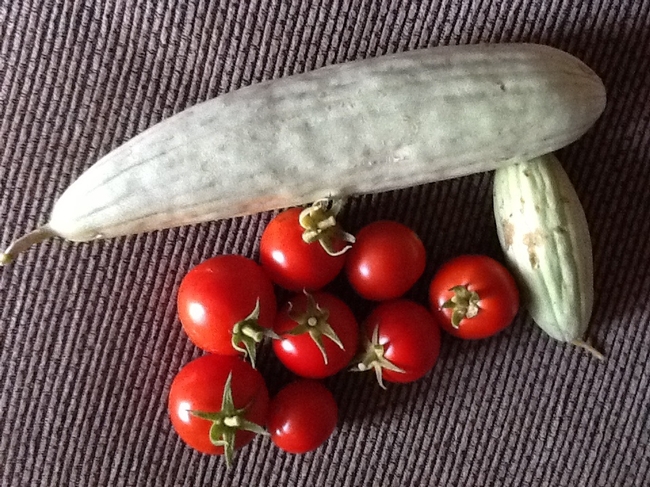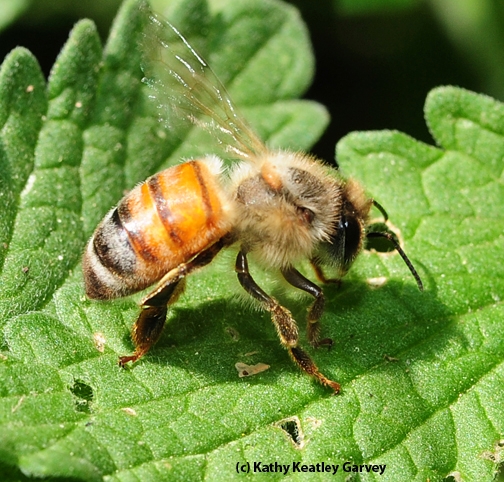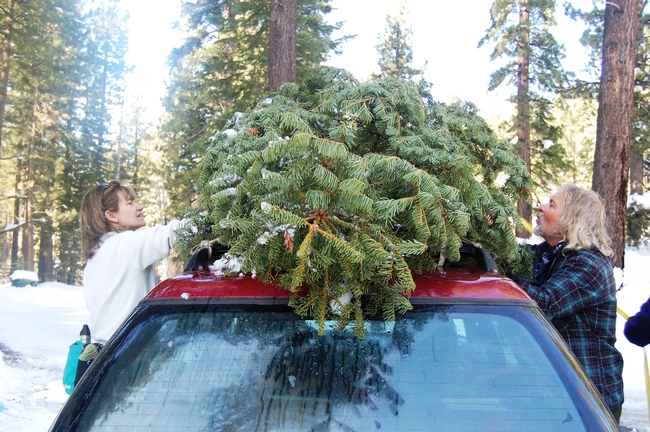UC Blogs
Farmers Almanac says K.I.S.
Warm days have extended my summer garden, so I have appreciated the extra sun. However, you may have noticed that we are severely lacking in rainfall. In fact, Vallejo has had .08 inches of rain to date, while the average is 1.2 inches with 2.44 inches as the historical maximum. No or low precipitation is rarely good news for gardeners, but according to the Farmer's Almanac, today is a "Barren Day" anyway, so don't try to do any planting. Instead, you can give yourself a break and just focus on 'simple' tasks, like watering, weeding or prepping your garden for winter veggies.
But if you are a believer in planting by the phases of the moon, then do your planting this Sunday when there is a full moon! A full moon is said to encourage germination and growth.
Whatever your beliefs or your methods, Happy Gardening! It's nice to have an interest that we can essentially participate in year-round!
NOVEMBER 2013
14th-16th Neither Plant Nor Sow On These Barren Days.
17th-18th Plant Root Crops Where Climate Permits. Good Days For Transplanting.
19th-20th Any Seed Planted Now Will Tend To Rot.
21st-22nd Best Planting Days For Fall Potatoes, Turnips, Onions, Carrots, Beets, And Other Root Crops Where Climate Is Suitable. Also Plant Seedbeds And Flower Gardens. Good Days For Transplanting.
23rd-27th Poor Period For Planting. Kill Plant Pests, Clear Fencerows/land.
28th-29th Favorable Days For Planting Root Crops. Fine For Sowing Grains, Hay, And Forage Crops. Plant Flowers.
30th Plant Carrots, Beets, Onions, Turnips, Irish Potatoes, And Other Root Crops In The South. Lettuce, Cabbage, Collards And Other Leafy Vegetables Will Do Well. Start Seedbeds. Good Day For Transplanting.
http://www.farmersalmanac.com/calendar/gardening/

Final yield of cucumbers and tomatoes. (photo by JoEllen Myslik)
Bees in Crisis
A few months ago I wrote an article about the importance of planting bee-attracting plants in our gardens to hopefully counteract the alarming effects of Colony Collapse Disorder in the bee population across our country. In my research for that article I learned about neonicotinoids, which are a new type of pesticide suspected of contributing to that disorder. Since then I have read several new pieces, done more research into the topic and learned some worrisome information. Let me share some of that with you.
Firstly, some background: according to Wikipedia, "Neonicotinoids are a class of neuro-active insecticides chemically similar to nicotine. The development of this class of insecticides began with work in the 1980s by Shell and the 1990s by Bayer.[1] The neonicotinoids were developed in large part because they show reduced toxicity compared to previously used organophosphate and carbamate insecticides. Most neonicotinoids show much lower toxicity in mammals than insects, but some breakdown products are toxic.[2] Neonicotinoids are the first new class of insecticides introduced in the last 50 years, and the neonicotinoid imidacloprid is currently the most widely used insecticide in the world.[3] The neonicotinoids include acetamiprid, clothianidin, imidacloprid, nitenpyram, nithiazine, thiaclopridandthiamethoxam." And Dinotefuran.
The connection between these products and the death of so many bees is becoming more widely suspected. In a July edition of "The Hill", it was reported that H.R. 2692- Saving America's Pollinators Act of 2013 had been introduced into Congress, to stop the use of these pesticides and require the EPA to do more extensive research into their effects. (http://thehill.com/blogs/congress-blog/energy-a-environment/312023) It was sent to committee on July 16th and there it has sat. In a January, 2013 report of the European Food Safety Authority neonicotinoids were identified as a definite risk to honey bees. The EPA reported that beginning in December of 2013 and for 2 years forward the use of these pesticides will be severely restricted in Europe. But not here.
In searching the Internet I found that neonicotinoids are in a large variety of products, which may be purchased in stores around town and on such sites as Amazon.com and ebay. Those products include (but I'm sure are not limited to): sprays for insect control of lawns and turf grasses; pesticidal products (sometimes combined with fertilizers) for vegetables and fruits, (citrus fruit, grapes, cotton, canola, cereals, cherries, cucumbers, melons, onions, peaches, rice, stone fruit, strawberries, sugar beets, tea, tobacco, pears, apples, peppers, plums, potatoes, tomatoes) house plants and ornamentals; insecticides to kill bed bugs, leaf miners, grubs, aphids, white flies and beetles; and pet supplies to kill ticks and fleas. So, yes, they are everywhere.
Just as with any other pesticide, there may be good reason to use them at times, but the less we use the better and we certainly want to know if they are in the products that we are buying. So reading labels and steering clear of the ingredients mentioned above should be a pretty effective means by which to feel confident about our purchases. You would think.
However, it has recently been reported that some of the plants sold in "big box store nurseries" are grown from seeds pre-treated with neonicotinoids. Yikes! I learned this after I had purchased from one of those "big boxes" a beautiful chrysanthemum this summer. Had I killed bees??? I was feeling tricked. So I have since made a few phone calls.
I asked a salesman in the garden department at Lowe's whether the seeds for their plants had been pre-treated with pesticides. The answer was, "yes". He explained that they have many growers from whom they buy, and those plants coming from out-of-state and from SoCal were indeed pre-treated. Those coming from "here", he said, were not. A call to Home Depot got me an "I'm not sure" response. Two of their vendors are Hines and Color Spot. I was not able to contact anyone at Hines, but did call the ColorSpot corporate offices, and was re-routed from Customer Service to Grower information, where the recording asked for my message. We'll see whether or not I get a response. I did, however, note that all the ColorSpot Nurseries are located from Salinas south to Fallbrook and across the southwest to Texas. We must draw our own conclusions.
Suffice it to say, there is reason to be concerned. Friends Of The Earth now has a BeeAction campaign going on. The Sierra Club has Sierra Rise that is expressing the same concern. And, interestingly, Bayer on their crop science website has a whole little section devoted to the importance and care of bees. http://www.bayercropscience.us/our-commitment/bee-health
Bee forewarned and bee careful!

Photo courtesy of Bayer cropscience website of bee
Maintaining postharvest quality of persimmons
Post By: Carlos H. Crisosto Director of UC Fruit & Nut Research and Information Center Department of Plant Sciences University of California,...
What's Wrong with My Bees?
"What's wrong with my bees?" That's a question frequently asked of Extension apiculturist Eric Mussen of the UC Davis Department of Entomology and...

This honey bee is doing poorly. (Photo by Kathy Keatley Garvey)
Cutting down a Christmas tree is sustainable family fun
Every year, the day after Thanksgiving, Susie Kocher bundles up her children, gathers the extended family and hikes into the Lake Tahoe Basin forest to find a Christmas tree.
“It’s my favorite part of the season,” Kocher said. “Having the fresh, living thing in the house really symbolizes the holiday. You can’t do it with a fake tree.”
Kocher, a forester and the natural resources advisor for UC Cooperative Extension in the Central Sierra, lives and works in Lake Tahoe. The Lake Tahoe Basin Management District is one of nine national forests in California, all of them in the northern part of the state, where the U.S. Forest Service allows Christmas tree cutting with a $10 permit.
Though some people mourn the death of any tree, Kocher says careful selection and removal of Christmas trees is an enchanting family tradition that enriches forest health.
“We have a lot of small trees on public lands because of fire suppression,” Kocher said. “They’re all competing with one another and many will ultimately die. A smart harvest of Christmas trees can improve the forest by helping with thinning.”
People with permits to cut down Christmas trees in national forests must follow strict guidelines. The trees must be within 10 feet of another living tree, the base of the trunk cannot be more than six inches wide and it must be cut within six inches of the ground. Some national forests limit the harvest to certain tree species.
Despite committing to these guidelines when obtaining a permit, Kocher said she has seen some Christmas tree harvesters make ill-advised choices.
“Some are too lazy to find a good tree and will cut the top off a large tree,” Kocher said. “You can be driving around and see what looks like a poor old Dr. Suess tree, which is what grows from the ugly remnant left behind in the forest.”
Such irresponsible Christmas tree cutting has led some forests to discontinue Christmas tree harvesting for personal use.
Kelly Hooten, information specialist with the Sierra National Forest, said the organization stopped issuing Christmas tree cutting permits because people would tend to cut down only healthy, strong trees.
“It’s really the sickly, Charlie Brown trees that we would prefer to thin in our forest,” Hooten said.
The El Dorado National Forest does not allow Christmas tree cutting because there are more than 30 Christmas tree farms in the vicinity where visitors can choose and cut down their own trees.
“Allowing Christmas tree cutting in forests would hurt these farmers economically,” said Lynn Wunderlich, UCCE advisor in the Central Sierra office. Many Christmas tree farmers also provide food, crafts, activities and visits with Santa.
“Families can visit the farmer year after year as their children grow, so that’s part of the experience,” Wunderlich said.
There has been ongoing debate about whether a fake tree or real tree is more environmentally friendly, but for Kocher, there is no question.
“Fresh real trees are a renewable resource, fake trees are not,” she said. “It’s an agricultural product. You can contribute to a local farmers’ income or you can help thin the forest. Picking and bringing home a fresh tree, decorating it and smelling it defines the season for me. Without it, I don’t think it would feel like Christmas.”


